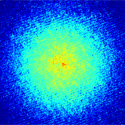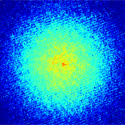Repelling atoms reach quantum unison more easily
A group of atoms hovering near absolute zero temperature will meld into a single quantum state, like a giant “super-atom.” The exact temperature where this so-called Bose-Einstein condensate occurs has been debated for more than half a century. To help settle the issue, experimentalists reporting in Physical Review Letters have observed that condensation occurs at higher temperatures for atoms that repel each other.
In , Einstein predicted that noninteracting particles cooled to a certain temperature will begin to all condense into the lowest available energy state. However, atoms typically repel each other, and theorists have been unable to agree whether this repulsion raises or lowers the transition temperature with respect to the noninteracting case. Since , Bose-Einstein condensates have been observed in the lab at a few hundred nanokelvin, but the experimental designs have not made it clear what effect atomic interactions have.
To probe the underlying physics, Robert Smith and his colleagues at the University of Cambridge, UK, cooled potassium atoms in an optical trap, while applying a magnetic field that induced an added repulsion between the atoms. The researchers could tune the strength of this repulsion and then measure the temperature at which the atoms condensed. After accounting for changes in the gas density, the team found that repulsion actually elevated the transition temperature by a few percent. A qualitative explanation for this counterintuitive result is that repulsive collisions redistribute momentum more uniformly between the atoms and thus ease the transition to a single momentum state. – Michael Schirber





